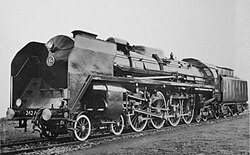Smoke deflector

Smoke deflectors are pieces of equipment for railway vehicles .
Steam locomotives
function
They are used on steam locomotives to influence the airstream in such a way that the smoke and exhaust steam emitted from the chimney in front (from the steam engine of the locomotive ) is deflected away from the windows of the driver's cab . For this purpose, the smoke deflectors developed by Albert Betz at the Aerodynamic Research Institute in Göttingen were attached on both sides of the chimney parallel to the long boiler . The use of smoke deflectors is particularly useful at higher speeds, as smoke and exhaust steam could otherwise seriously hinder the view of the locomotive staff , especially at speeds above 80 km / h .
commitment
The spread of smoke deflectors on steam locomotives differed depending on the railway company . From the mid-1920s they were often used in locomotives of the Deutsche Reichsbahn and the French SNCF . Later, the Deutsche Bundesbahn , like the Deutsche Reichsbahn in the GDR, retained smoke deflectors on steam locomotives.
For the locomotives of some railway companies, smoke deflectors and their special shape were part of an unmistakable appearance. For example, the steam locomotives of the pre-war Reichsbahn had large sheet metal that rose from the boiler circuit above the wheels to below the chimney height and had a kink at the top so that they followed the vehicle gauge. This large smoke deflector, which is so characteristic of most standard locomotives, was divided into a small, medium-sized and large substructure. Later they were referred to as Wagner smoke deflectors after Richard Paul Wagner , the Reichsbahn's long-standing design department head .
Friedrich Witte carried out wind tunnel tests with the 52 2328 together with Professor Mölbert from the University of Hanover in 1943 . The result was the smaller Witte smoke deflector , which no longer reached down to the boiler circuit or even to the front buffer beam. The new smoke deflector saves a lot of material while at the same time improving the route visibility for the locomotive staff. After the war, smoke deflectors of this type were often installed on the DR and DB instead of the larger Wagner smoke deflectors on brand new or rebuilt steam locomotives.
The steam locomotives of the 01.5 series were to receive special smoke deflectors , which tapered towards the top. The so-called " bat ears " did not prove their worth, however, and baffles were installed instead, which were similar to the Witte smoke deflectors.
In several Eastern European countries (Poland, Bulgaria) the smoke deflectors were attached to the boiler directly next to the chimney, for example in the PKP series TKt48 . The same applies to many streamlined steam locomotives, for example the DR class 01.10 .
Picture gallery
German standard locomotive of the series 01 with Wagner smoke deflectors
DR series 52 with Witte smoke deflectors
French SNCF 242 A 1 with smoke deflectors
Individual evidence
- ^ Sven Grünewald: cradle of aviation research . In: Polygo Verlag GmbH & Regionalverband Südniedersachsen eV (Ed.): RegJo . No. 54 . Polygo Verlag GmbH, 2010, ISSN 1615-5696 , p. 28 .
- ↑ Wolf-Heinrich Hucho: Aerodynamics of the blunt body . Physical fundamentals and practical applications. Vieweg + Teubner, Wiesbaden 2011, ISBN 978-3-8348-1462-3 , pp. 307 .




